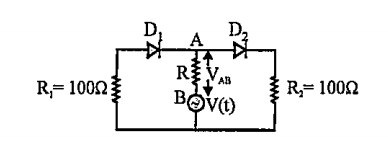Resistance R is 200 Ω and the sinusoidal alternating emf device operates at amplitude Em=36.0 V and frequency fd=60.0 Hz.
(a) What is the potential difference vR(t) across the resistance as a function of time t, and what is the amplitude VR of VR(t) ?
(b)What is the current vR(t) in the resistance and the amplitude IR of IR(t) ?
To solve the problem step by step, we will address each part of the question systematically.
Part (a): Potential Difference across the Resistance
1. Identify the given values:
- Resistance, R=200Ω
- Amplitude of EMF, Em=36.0V
- Frequency, fd=60.0Hz
2. Calculate the angular frequency (ω):
ω=2πfd=2π×60=120πrad/s
3. Write the expression for the alternating EMF:
The EMF as a function of time is given by:
E(t)=Emsin(ωt)=36sin(120πt)
4. Determine the potential difference across the resistance:
In a purely resistive circuit, the potential difference across the resistor is equal to the EMF applied:
vR(t)=E(t)=36sin(120πt)
5. Identify the amplitude VR of vR(t):
The amplitude VR is simply the maximum value of the potential difference:
VR=Em=36V
Summary of Part (a):
- The potential difference across the resistance as a function of time is:
vR(t)=36sin(120πt)V
- The amplitude VR is:
VR=36V
---
Part (b): Current through the Resistance
1. Use Ohm's Law to find the current:
The current I(t) through the resistor can be expressed as:
I(t)=vR(t)R
2. Substituting vR(t):
I(t)=36sin(120πt)200
3. Simplify the expression:
I(t)=0.18sin(120πt)A
4. Identify the amplitude IR of I(t):
The amplitude IR is the maximum value of the current:
IR=EmR=36200=0.18A
Summary of Part (b):
- The current through the resistance as a function of time is:
I(t)=0.18sin(120πt)A
- The amplitude IR is:
IR=0.18A
---
- Resistance, R=200Ω
- Amplitude of EMF, Em=36.0V
- Frequency, fd=60.0Hz
ω=2πfd=2π×60=120πrad/s
The EMF as a function of time is given by:
E(t)=Emsin(ωt)=36sin(120πt)
In a purely resistive circuit, the potential difference across the resistor is equal to the EMF applied:
vR(t)=E(t)=36sin(120πt)
The amplitude VR is simply the maximum value of the potential difference:
VR=Em=36V
- The potential difference across the resistance as a function of time is:
vR(t)=36sin(120πt)V
- The amplitude VR is:
VR=36V
The current I(t) through the resistor can be expressed as:
I(t)=vR(t)R
I(t)=36sin(120πt)200
I(t)=0.18sin(120πt)A
The amplitude IR is the maximum value of the current:
IR=EmR=36200=0.18A
- The current through the resistance as a function of time is:
I(t)=0.18sin(120πt)A
- The amplitude IR is:
IR=0.18A
Topper's Solved these Questions
- ELECTROMAGNETIC OSCILLATIONS AND ALTERNATING CURRENT BOOK - RESNICK AND HALLIDAYCHAPTER - ELECTROMAGNETIC OSCILLATIONS AND ALTERNATING CURRENT EXERCISE - Check Point
8 Videos
- ELECTROMAGNETIC OSCILLATIONS AND ALTERNATING CURRENT BOOK - RESNICK AND HALLIDAYCHAPTER - ELECTROMAGNETIC OSCILLATIONS AND ALTERNATING CURRENT EXERCISE - Problems
30 Videos
- ELECTROMAGNETIC INDUCTIONBOOK - RESNICK AND HALLIDAYCHAPTER - ELECTROMAGNETIC INDUCTIONEXERCISE - PRACTICE QUESTIONS (Integer Type)
14 Videos
- ELECTROMAGNETIC WAVES BOOK - RESNICK AND HALLIDAYCHAPTER - ELECTROMAGNETIC WAVES EXERCISE - PRACTICE QUESTIONS (Integer Type)
3 Videos
Similar Questions
Inductance L is 230 mH and the sinusoidal alternating emf device operates at amplitude Em =36.0 V and frequency fd=60.0 Hz.
(a) What are the potential difference vL(t) across the inductance and the amplitude VL of vL(t) ?
View SolutionCapacitance C is 15.0 μF and the sinusoidal alternating emf device operates at amplitude Em = 36.0 V and frequency fd= 60.0 Hz.
(a) What are the potential difference VC(t) across the capacitance and the amplitude VC of Vc(t) ? (b) What are the current IC(t) in the circuit as a function of time and the amplitude IC of Ic(t) ?
View Solution
Knowledge Check
An alternating voltage is connected in series with a resistance R and inductance L if the potential drop across the resistance is 200V and across the inductance is 150V, then the applied voltage is
A350VB250VC500VD300VIf the potential difference between A and D is V, what will be potential difference between F and C. each of the resistance is R.
 AV/3BV/4CV/6DV/8
AV/3BV/4CV/6DV/8The heat developed in an electric wire of resistance R by a current I for a time t is
AI2Rt4.2calBI2RCI2R4.2tcalDRt4.2I2cal
A coil with active resistance R and inductance L was connected at the moment t=0 to a source of voltage V=Vmcosωt. Find the current in the coil as a function of time t.
View SolutionIf we increase the driving frequency in a circuit with a purely resistive load, do (a) amplitude VR and (b) amplitude IR increase , decrease, or remain the same ?
View SolutionIn the circuit given below, V(t) is the sinusoidal voltage source, voltage drop VAB(t) across the resistance R is

View SolutionWhen some potential difference V is applied across a resistance R then the work by the electrical field on the charge q to flow through the circuit in time t will be
View SolutionIn the circuit given below, V(t) is the sinusoidal voltage source, voltage drop VAB(t) across the resistance R is

View Solution